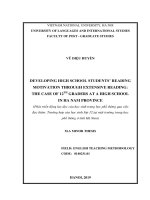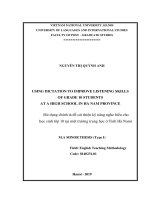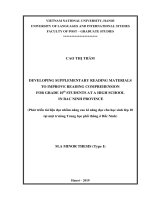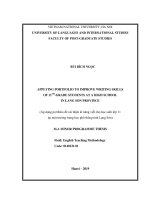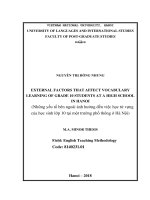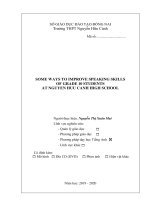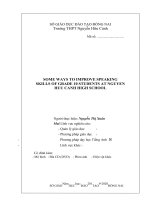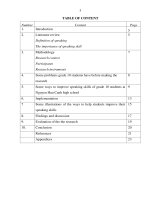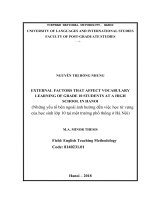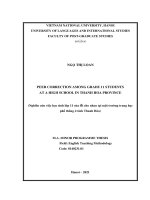Using dictation to improve listening skills of grade 10 students at a high school in ha nam province
Bạn đang xem bản rút gọn của tài liệu. Xem và tải ngay bản đầy đủ của tài liệu tại đây (1.31 MB, 81 trang )
VIETNAM NATIONAL UNIVERSITY, HANOI
UNIVERSITY OF LANGUAGES AND INTERNATIONAL STUDIES
FACULTY OF POST – GRADUATE STUDIES
*********************
NGUYỄN THỊ QUỲNH ANH
USING DICTATION TO IMPROVE LISTENING SKILLS
OF GRADE 10 STUDENTS
AT A HIGH SCHOOL IN HA NAM PROVINCE
(Sử dụng chính tả để cải thiện kỹ năng nghe hiểu cho
học sinh lớp 10 tại một trường trung học ở Tỉnh Hà Nam)
M.A MINOR THESIS (Type I)
Field: English Teaching Methodology
Code: 8140231.01
Hanoi - 2019
VIETNAM NATIONAL UNIVERSITY, HANOI
UNIVERSITY OF LANGUAGES AND INTERNATIONAL STUDIES
FACULTY OF POST – GRADUATE STUDIES
*********************
NGUYỄN THỊ QUỲNH ANH
USING DICTATION TO IMPROVE LISTENING SKILLS
OF GRADE 10 STUDENTS
AT A HIGH SCHOOL IN HA NAM PROVINCE
(Sử dụng chính tả để cải thiện kỹ năng nghe hiểu cho
học sinh lớp 10 tại một trường trung học ở Tỉnh Hà Nam)
M.A MINOR THESIS (Type I)
Field: English teaching methodology
Code: 8140231.01
Supervisor: Prof. Dr. Hoàng Văn Vân
Hanoi – 2019
DECLARATION
I certify that the minor thesis entitled “Using dictation to improve listening
skills of grade 10 students in a high school in Ha Nam province” and the work
presented in it is the result of my own work, and that the minor thesis or any part of
the same has not been submitted to any university and institution. I also accept all
the requirements of ULIS relating to the retention and use of M.A Graduation
Thesis deposited in the library.
Hanoi, October 2019
Author‟s signature
Nguyễn Thị Quỳnh Anh
i
ACKNOWLEDGEMENTS
I would first like to express my deep gratitude to my supervisor Prof. Dr. Hoàng
Văn Vân for his valuable guidance, encouragements, criticisms and correction
throughout my research. Without his help, this study would be far from finished. He
consistently allowed this paper to be my own work, but steered me in the right
direction whenever he thought I needed it.
I am greatly indebted to all my lecturers at Faculty of Post-graduate Studies
of University of Languages and International Studies – Vietnam National
University, Hanoi who have provided me an invaluable source of knowledge for my
completion of this thesis.
I would also like to thank fourty 10th grade students at a local school in Ha
Nam province. Without their passionate participation and input, the validation
survey could not have been successful.
I must express my very profound gratitude to my family and friends whose
unfailing support and continuous encouragement help me throughout my years of
study and the process of researching and writing this thesis. This accomplishment
would not have been possible without them.
Last but not least, I wish to thank my readers for their interest and comments
on the thesis.
Hanoi, October 2019
Author‟s signature
Nguyễn Thị Quỳnh Anh
ii
ABSTRACT
How to improve English listening skill effectively is always a topic that has
attracted much attention from language teachers. Students of English find listening
lessons difficult because they do not have appropriate methods to get over the
difficulties. As a result, this research attempts to look at one method called dictation
to improve high school students‟ listening skills. This study is conducted to find
out: (1) a clear view of dictation, (2) how the method works on the students, and (3)
how much the student‟s listening skills are improved. The data were collected
through action research with 40 grade 10 students in a local high school in Ha Nam
province. All of the groups were pre-tested at the beginning of the study.
Throughout the learning process in class for 18 weeks, the teacher gave the students
dictation practice tasks. All students in the class were post-tested at the end of the
intervention. For the detailed outcome, the data was collected and analyzed
carefully. An analysis of survey questionnaires is done on the students to find out
their attitudes towards this technique. As the findings show, the research reveals
that dictation contributes positively to improving listening skills for students.
iii
TABLE OF CONTENTS
DECLARATION ..............................................................................................................i
ACKNOWLEDGEMENTS .............................................................................................ii
ABSTRACT ................................................................................................................... iii
LIST OF TABLES .........................................................................................................vii
LIST OF CHARTS ...................................................................................................... viii
CHAPTER 1: INTRODUCTION .................................................................................... 1
1.1. Statement of the problem and rationale of the thesis ..................................1
1.2. Aims of the thesis ............................................................................................3
1.3. Scope of the thesis ...........................................................................................3
1.4. Methods of the thesis ......................................................................................4
1.5. Significance of the thesis ................................................................................4
1.6. Design of the thesis..........................................................................................5
CHAPTER 2: LITERATURE REVIEW ......................................................................... 6
2.1. Listening ..........................................................................................................6
2.1.1. Definition of listening................................................................................6
2.1.2. The importance of listening ......................................................................7
2.1.3. Listening problems ....................................................................................8
2.2. Dictation ...........................................................................................................9
2.2.1. History of dictation ....................................................................................9
2.2.2. Definition of dictation ...............................................................................9
2.2.3. Characteristic of dictation .......................................................................10
2.2.4. Types of dictation .....................................................................................11
2.2.5. The advantages of dictation ....................................................................12
2.2.6. The disadvantages of dictation ................................................................14
2.2.7. Related studies .........................................................................................14
2.3. Summary........................................................................................................16
iv
CHAPTER 3: RESEARCH METHODOLOGY ........................................................... 17
3.1. Research site .................................................................................................17
3.2. Research design .............................................................................................20
3.2.1. Initial relection ........................................................................................21
3.2.2. Planning ...................................................................................................22
3.2.3 Action and observation ............................................................................22
3.2.4. Reflection .................................................................................................25
3.3. The participants ............................................................................................26
3.4. Research questions........................................................................................26
3.5. The data collection instruments ..................................................................27
3.5.1. Pre- and Post-tests ...................................................................................27
3.5.2. Questionnaires .........................................................................................28
3.6. Method of data analysis................................................................................29
3.6.1. Quantitative data .....................................................................................29
3.6.2. Qualitative data ........................................................................................29
3.7. Summary........................................................................................................30
CHAPTER 4: FINDINGS AND DISCUSSION ........................................................... 30
4.1. Analysis of listening practice tasks ..............................................................30
4.1.1. Standard dictation ...................................................................................31
4.1.2.
Error identification ..............................................................................31
4.1.3. Jigsaw dictation .......................................................................................31
4.1.4. Listening cloze .........................................................................................32
4.1.5. Elicited imitation .....................................................................................32
4.2. Analysis of the listening tests .......................................................................33
4.3. Analysis of the survey questionnaire ..........................................................36
4.4. Discussion of the findings .............................................................................40
4.4.1. Achievement and difficulties ...................................................................41
4.4.2. Attitudes ...................................................................................................43
4.5. Summary........................................................................................................43
v
CHAPTER 5: CONCLUSION ....................................................................................... 45
5.1. Summary of the study ..................................................................................45
5.2. Pedagogical implications ..............................................................................45
5.3. Recommendations .........................................................................................46
For the other researchers ..................................................................................47
5.4. Limitations of the study and suggestions for further research ................47
5.6. Conclusion .....................................................................................................48
REFERENCES ............................................................................................................... 49
APPENDICES.................................................................................................................. I
APPENDIX 1 : A Lesson Plan......................................................................................... I
APPENDIX 2: Pre-Test .............................................................................................. VIII
APPENDIX 3: Dictation 1: Unit 1: Family Life............................................................XI
APPENDIX 4: Dictation 2: Unit 2: Your Body And You ........................................... XII
APPENDIX 5: Dictation 3. Unit 3: Music ..................................................................XIV
APPENDIX 6: Dictation 4: Unit 4: For A Better Community .................................... XV
APPENDIX 7: Dictation 5: Unit 5: Invention ............................................................XVI
APPENDIX 8: Post-Test ........................................................................................... XVII
APPENDIX 9: Questionnaires ..................................................................................... XX
vi
LIST OF TABLES
Table 4.1: Listening practice task for dictation 4......................................................... XV
Table 4.2: The results of pre-test and post-test .............................................................. 33
Table 4.3. Student‟s response to the questionnaires ...................................................... 37
vii
LIST OF CHARTS
Chart 3.2 Action Research Model (Source: Kurt Lewin, (1934)) .................................. 21
Chart 3.2.3: Conceptual framework ............................................................................... 25
Chart 4.2: Students‟ mean score of average mark ......................................................... 36
Chart 4.3.1: Students‟ attitudes towards dictation ......................................................... 38
Chart 4.3.2. The benefits of dictation ............................................................................. 39
Chart 4.3.3. Student‟s difficulties when doing dictation................................................ 40
viii
CHAPTER 1: INTRODUCTION
In this chapter, the researcher will set the introduction of the study, including:
the rationale for the study, the aims, the scope, the method of the study, and the
design of the thesis.
1.1. Statement of the problem and rationale of the thesis
Language plays such an indispensable part in our life as a means of both spoken
and written communication. By using language, people can express their feelings
and thoughts to communicate with others in fulfilling their daily demands so that
close relation among members of the group can be carried out (Ramelan, 1993: 8).
Ramelan further states that “The use of language enables the members of a social
group to cooperate with one another for their own benefit.”
It can not be denied that English nowadays is not only a language to
communicate among people but also a connection among countries in many fields
such as science, education, tourism, industry, trade and so forth. In Vietnam at
present, English is a compulsory subject from lower secondary education because of
its role in industrialization and modernization of the country. On the basis of the
National Curriculum, teachers are expected to teach their students five basic aspects
which are Speaking, Listening, Reading, Writing, and language knowledge
(phonology, lexis, and grammar). As a matter of fact, in the process of teaching and
learning English, listening seems to play an important role. It gives the learner
information to build the knowledge which is necessary for using the language.
Listening provides the vital input for learners to acquire the language and somehow
it promotes speaking skill. However, for the students, listening skill is always
supposed to be the most difficult one because from the very first place of learning
English, Vietnamese students seem to pay more attention to learning grammar,
vocabulary. Unlike other language skills such as reading and writing, which learners
1
can observe directly, listening is an abstract, intricate “process of hearing,
identifying, understanding and interpreting spoken language” (Lewis, 2007). Many
students have significant problems with listening. The speed, the reduced forms, the
use of intonation, and unfamiliar accents, all ask learners at all levels a great deal of
practice. Therefore, the choice of the appropriate method is a great significance in
developing listening skills and student‟s overall language learning.
At a local high school where the researcher has been working, students‟ listening
skill presents a big problem that the teachers of English here have to deal with.
Several techniques have been applied to teaching and learning English, however,
most of them have not been appropriate and effective. One of the techniques to
improve listening comprehension which is recommended in many books about
teaching EFL in general and teaching listening comprehension, in particular, is
dictation (Celce-Murcia, 1995; Gilbert, 1996; Ur, 1991). According to researchers‟
opinion, dictation brings about a variety of benefits. For instance, Lightfoot (2004)
pointed out that dictation could be done with any level, depending on the text
carefully designed and applied and it could be graded for a multi-level class.
Montalvan (2006) maintained that dictation involved the whole class, no matter
how large it was. The dictation text can be completely prepared beforehand and
administered quite effectively by any inexperienced teacher. As a result, Pappas
(1977) regards dictation as a good means of improving learners‟ listening skill.
For grade-10 students‟ problems of poor listening comprehension and as one of
the teachers of English in this school, the researcher would like to improve the
students‟ listening skills and hope that this method can improve the students‟
listening skills. All considered, a study on “Using dictation to improve grade-10
students‟ listening skill at a high school in Ha Nam province” was conducted
2
1.2. Aims of the thesis
In traditional listening teaching methods in general and, in particular, teaching
listening tends to treat students equally. Teachers have tendencies to present the
same in-class exercises and activities to all learners and expect the same outcome.
In present, with the development of high technology, numerous techniques to teach
listening are applied in listening lessons; however, dictation is still a good method
to be used to teach listening when it has various implications for educators in terms
of classroom instructions.
The overarching aim is to find out whether students can improve listening
skill through dictation. Therefore, the study is carried out with the aim of finding
the answers to the following question:
1. To what extent does dictation contribute to improving English listening skills
of the grade-10 students at a local high school?
2. What are students’ attitudes towards this listening technique?
1.3. Scope of the thesis
Due to the limits of the time, ability and condition, it is unable to cover the
whole achievement test for all students in a local high school but focus on the
listening tests as a part of achievement test for a class of grade-10 students. It
provides the general theory of language teaching, analyzed data of the test as well as
the students‟ comments to investigate the effectiveness of dictation to enhance
English listening skill for grade 10-students (about 40 students) at a local high
school. To be more convenient, one class the researcher has been teaching as the
object of the investigation was chosen.
3
1.4. Methods of the thesis
Both quantitative and qualitative methods were used to achieve the aims
stated. The data collected for the study is analyzed from the results of pre-test and
post-test as well as students‟ survey questionaires.
Pre-test and post-test which have been examined to have an equivalent difficulty
level, are used to test students‟ listening skills before and after the project. The pretest is delivered to students before the intervention and the post-test is used to
collect the scores and then compare to the scores of the pre-test.
The qualitative research method through survey questionaires are conducted to
aim at finding out the students‟ attitudes towards dictation as well as their
comments on using dictation in the English lessons.
1.5. Significance of the thesis
In fact, dictation was generally applied in English teaching and learning, and
there has been a wide range of studies about the implications of this theory.
However, there were a few studies about its effectiveness on improving listening
skills.
The findings of the thesis may serve as useful information not only for the
researcher, involved students but also for all language teachers. In particular, the
study is conducted to improve listening competence of grade-10 students at a local
high school. Therefore, the results of this study may be generalized to apply for
students at the same level in other schools. It is also hoped that the thesis will make
a contribution to the achievement in listening learning of students at different levels.
Besides, this study may also bring new insights into language teaching when
recommendations for other researches are stated with the hope of taking the most
advantages of the using dictation as a model for listening teaching.
4
1.6. Design of the thesis
This thesis is divided into five chapters as follows:
CHAPTER 1: INTRODUCTION provides the basic information such as the
nationale of the study, aims of the study, scope of the study, methods of the study
and design of the study.
CHAPTER 2: LITERATURE REVIEW presents key concepts such as
definition of listening, listening as the final goal of learning a language, listening as
a means of acquiring language, and evaluation standard on listening skill. In
addition, the followings are also included in this chapter: the history of dictation,
definition of dictation, characteristics of dictation, type of dictations and so forth.
CHAPTER 3: RESEARCH METHODOLOGY describes the method of
investigation consisting of research site, research questions, participants,
instruments, methods of data collection and analysis.
CHAPTER 4: DATA ANALYSIS AND DISCUSSION presents the detailed
results of the survey including Data analysis and Discussion, gives a detailed
presentation of data and a detailed description of data analysis.
CHAPTER 5: CONCLUSION provides the conclusion of the research, points
out limitations and makes some suggestions with future directions on the
improvement of dictation test for grade-10 students.
REFERENCES AND APPENDIX come at the end of the study
5
CHAPTER 2: LITERATURE REVIEW
Any research has theories as its background. In this minor thesis, the
researcher bases the study on the theories which are the views of the famous applied
linguists. This section contains the definitions of listening, learning to listen, types
of listening, listening problems, types of classroom listening performance, and
assessment of listening.
2.1. Listening
2.1.1. Definition of listening
There are various definitions of listening. The first definition is that listening is a
crucial element of oral communication, or the interactive process. Listening is such
an essential part of the communication process. Students spent the majority of their
time at school listening and most of what students know is acquired through
listening. They can listen and express themselves orally to communicate with
others.
Myers and Myers (1988: 143) define that listening is not just hearing. It includes
understanding, paying attention, analyzing, evaluating the spoken messages, and
possibly acting on the basis of what has been heard.
Listening is the ability to identify and understand what the speaker is saying
through understanding his accent, pronunciation, grammar, vocabulary and
comprehension of meaning (Howatt and Dakin, 1974 ). (Rost, 1994) draws a
particular list of components to master when dealing with this skill:
- Discriminating between sounds.
- Recognizing words.
- Identifying stressed words and grouping of words.
6
- Identifying functions (such as apologizing, suggesting, advising and so on) in
conversations.
- Connecting linguistic cues to paralinguistic cues (intonation and stress) and to
non-linguistic cues (gestures and relevant objects in the situation) in order to
construct meaning.
- Using background knowledge and context to predict and then to confirm
meaning.
- Recalling important words, topics and ideas.
- Giving appropriate feedback to the speaker.
- Reformulate what the speaker has said.
Rost (1994) insists on the fact that students must deploy all these sub-skills
to realize a successful process when he states: “Successful listening involves an
integration of these component skills. In this sense, listening is a coordination of the
component skills, not the individual skills themselves. This integration of these
skills constitutes a person's listening ability”.
Ma Lihua (2002) states that listening comprehension is a complex
psychological process of listeners‟ language understanding by hearing. Listening is
an interactive, not a passive skill, which the students need to put much effort and
practice. So as to listen effectively, the listeners must have sufficient knowledge of
the language he or she is listening to.
2.1.2. The importance of listening
Listening plays an important role in learning a foreign language, especially in
communication. We cannot communicate with others successfully unless we
understand what the speakers mean. A study conducted by Wilt (1950) states that
when communicating, 30 percent of communication was spent speaking, 16 percent
reading and 9 percent writing. The listeners sometimes misunderstand the speakers
because of their listening ability and how they response to what they have heard.
7
Listening to a second language seems to be so difficult. Besides, in class,
students have less chance to learn listening than learn speaking, reading, writing and
grammar. However, students can day by day enhance their listening skills by
practicing listening daily.
2.1.3. Listening problems
We need to identify the problems before finding the solutions to deal with them.
Following are some of the learner‟s problems and the solutions that Ur (1996: 111112) identifies:
a. Trouble with the sounds
Most students do not catch the words but they respond by understanding the
context.
b. Find it difficult to keep up
Some students feel worried, stressed or even tired and bored when they miss
some words of the text because much information comes so fast. Therefore, they
cannot concentrate on the lessons. The teacher should encourage and explain to the
students that there is no need listening to every word but try to get keywords.
c. Need to hear thing many times
In order to understand, students need more than once to hear the text. For
difficult texts, teachers can give students opportunities to listen more times.
Besides, Goh (2000) reports that some listeners complain that they quickly
forget what they have heard and then they easily miss the following information.
To deal with the students‟ difficulties in learning to listen, the teacher has to
identify and classify those difficulties. Then to make the lessons more effective,
teachers must select and design appropriate materials.
8
2.2. Dictation
2.2.1. History of dictation
Dictation is regarded as one of the oldest techniques introduced in the Middle
Age. It is known for testing progress in the learning of a foreign language. It was
used to transmit course content from teacher to students in both translation method
and traditional direct method.
2.2.2. Definition of dictation
David and Rinvolucri (1998) defines dictation as decoding the sounds of
(English) and recording them in writing. Dictation has been proved to be extremely
effective at all levels. It helps students to distinguish sounds and requires them to
transfer sounds into written words. It can be said that “dictation” is a process of
listening to something from the teacher and the students record it by writing down
in their notes.
In the Longman Dictionary of Language Teaching Applied Linguistics, Richards
(1999: 108) defines dictation as “a technique used in both language teaching and
language testing in which a passage is read aloud to student or test-takers, with
pauses during which they must try to write down what they heard as accurately as
possible”.
Many experts claim that dictation is such an effective teaching method for
teachers. Oller (1979: 39) states that:“Dictation is a task which requires the
processing of temporally constrained sequences of material in the language, divided
up the stream of speech and then refers down what is heard requires understanding
the meaning of the material.”
According to Taylor as quoted by Fachrurrazy (1989), “Dictation” means “ (1)
reading a passage aloud, (2) dividing the passage into phrases that are short
9
enough to remember and re-reading phrases with gap long enough for subjects to
record the preceding phrase in writing, (3) optionally re-reading each phrase as it
is being written, and (4) re-reading the whole passage as in (1).”
Dictation is when the teacher reads aloud the passage of around 150 words three
times. For the first time, the teacher reads the text without breaks at a normal speed,
while the students write down what they have heard. For the second time, the
teacher reads the passage in phrases and pauses long enough for students to write.
The last time the teacher once again reads the whole text at a normal speed, for
students to check what they have written.
2.2.3. Characteristic of dictation
Zhiqian (1989) states that dictation makes the lessons more and more efficient. It
has a numerous characteristics as follows:
(1) Dictation includes activities which are suitable for a wide range of levels and
ages. Dictation can be used in a class of any size. When the dictation
technique? is used, all of the students work at the same time, even in a very
large class.
(2) Students can learn in groups by creating their own text. In other word,
students can learn by their own with the teacher‟s guide or example.
(3) It gives students opportunities to get practice in note-taking that is very
necessary in any course, especially in learning languages.
(4) Dictation attracts students‟ attention in listening lessons. Dictation requires
students to focus on the exercise or they will miss words.
(5) Doing dictation is a good chance for students to practice listening, gaining
vocabulary, grammatical points and distinguishing sounds.
10
2.2.4. Types of dictation
Dictation can be classified into various types. Oller (1979), for example,
identifies five types of dictation: (i) standard dictation, (ii) partial dictation, (iii)
dictation with competing noise, (iv) dicto-Comp, and (v) and elicited imitation.
Standard dictation, according to Oller (Ibid.), is probably the most renown. Students
are required to write down what has been read by the teacher or played back from a
recording at a normal conversational speed. The students are given enough time to
challenge their short term memory. Partial dictation, also called spot dictation, is a
kind of standard dictation, but the students are given either the written version of the
text or the spoken one. The students must listen to the spoken text and fill in the
missing blank in the written version. Dictation with competing noise is rather
difficult because noise is added to the material. For example, the situation of the
communication is in public spaces or in the place where the television or the radio is
turned on. Dicto-Comp is a combination of two forms, namely dictation and
composition. The teacher reads the whole passage three times and then ask them to
write what they have heard after the third time as a reproduction. And elicited
imitation means that after listening to the material, students are asked to repeat or
recount what they have heard rather than write it down.
From another perspective, Rost (2002) also identifies dictation into five
categories: (i) fast speed dictation, (ii) pause and paraphrase, listening cloze, (iv)
error identification, and (v) jigsaw dictation. According to Rost (Ibid.), in fast speed
dictation the teacher reads a text at a natural speed, and the students can ask for as
many repetitions of any part of the passage as they want, but the teacher will not
slow down her reading speed. This activity attracts students‟ attention on features of
fast speech. In pause and paraphrase, Rost maintains, the teacher reads a passage
and pauses periodically for the students to write paraphrase but not a single word.
This activity focuses students on meaning, improving their vocabulary and how to
say things in a different way. In listening cloze, the teacher provides a passage with
11
missing words that the listeners fill in as they listen or after they listen. This activity
requires students to fill in the blanks with words, which helps students to focus on
particular language features. In error identification, the teacher provides a fully
transcribed passage with a number of errors. The students have to listen and identify
the errors, which draws students‟attention to detail by grammatical or semantic.
And in jigsaw dictation, students are asked to work in pairs. Each student keeping a
different part of the full dictation reads their parts to the other so as to complete the
passage. This activity encourages the negotiation of meaning.
2.2.5. The advantages of dictation
Lado (1977: 34) says that dictation serves many teachers and students
effectively. Frodesen (1991) reports that dictation can be “an effective way to
address grammatical error in writing that may be the result of erroneous aural
perception of English... Dictation can help students to diagnose and correct these
kinds of errors as well as others.”
According to Montalvana (2006), there are 21 advantages of dictation as follows
and the first six of them are the most important.
1. Dictation can help develop all four language skills in an integrative way.
2. It can help learn grammar.
3. Discussion helps to develop short-term memory.
4. Practice in careful listening will be useful later on in note-taking exercise.
5. Correcting dictation can lead to oral communication
6. Dictation fosters unconscious thinking in the new language.
7. Dictation is psychologically powerful and challenging.
8. Dictation can serve as an excellent review exercise
9. If the students do well, dictation is motivating.
10. Dictation involves the whole class, no matter how large it is.
11. During and after the dictation, all the students are active.
12
12. Correction can be done by the students.
13. Dictation can be prepared for mixed ability groups.
14. Dictation can be prepared for any level
15. The students, as well as the teacher, can get instant feedback (if the exercise is
corrected immediately)
16. The dictation passage can (and should) be completely prepared in advance (it
also can be taped).
17. Dictation can be administered quite effectively by an inexperienced teacher.
18. While dictating, the teacher can move about, giving individual attention.
19.
Dictation exercise can pull the class together, for example, during those
valuable first minute.
20. Dictation can provide access to interesting texts, by introducing a topic, for
example, or summarizing it, as in a dicto-comp.
21. Research has shown the learning to write down what you hear can encourage
the development literacy.
Lighfoot (2004: 23) says that dictation exercises are very important,
particularly for developing the children‟s awareness of phonic sounds. Lightfoot
says that there are several reasons for which dictation activities work well in the
classroom. From the teacher‟s point of view, dictation:
1) Can be done with any level, depending on the text used
2) Can be graded for a class at multi-levels.
For students, dictation:
a) Can focus on both accuracy (form) as well as meaning
b) Can develop all four skills (listening, speaking, reading, and writing) can be
develop if the students do the dictating rather than the teacher.
c) Give students the opportunity to notice features of pronouncing such as weak
forms, linking and elision.
13
2.2.6. The disadvantages of dictation
Beside a variety of benefits, dictation also brings some drawbacks such as
reading speed, memorizing, and spelling. Regarding to reading speed, in fact, by
dictation, students cannot distinguish the difference between the oral and the written
language. Additionally, teachers read texts at a slower speed; therefore, students are
still not familiar with the language spoken by natives. Memorizing in the short term
memory is sometimes a problem when there is too much information. Finally, in
some cases, students have difficulties in spelling. They can get the sound but cannot
spell and vice versa. For example, a lot of English learning beginners may not
distinguish between the short /ɔ/ and the long /ɔ:/ Therefore, they will make spelling
mistakes, which helps less in learning spelling or even pronunciation by dictation.
In addition, there are other disadvantages as follows. Alderson (1978a)
reports that the evidence concerning dictation is inconclusive and it is useful only as
a part of the battery of listening tests rather than a single solution. If the dictation is
not recorded on tape, the test will be less reliable, as there will be differences in, for
example, the speed of the text. The exercise can be unrealistic if the texts used have
been previously created to be read rather than heard. There is a close relationship
between the sounds and the spelling system. Therefore, in some cases, students
concentrate too much on single sounds and guess the single word but not the
meaning of the whole text. After that, with the limited memory span, the students
cannot retain what they have heard.
2.2.7. Related studies
Before this research, there were a number of the studies to explore the
relationship between dictation and listening skills as follows:
Firstly, the thesis was carried out by Nguyen Thi Minh Hang (2004) “English
Dictation Tests For First Year Students Of Business Administration Faculty, Hanoi
Foreign Trade University Problems And Solutions”. The research was done on 100
14
FTU second year students of Business Administration Faculty (three classes) and 20
teachers teaching the first year students. To collect the data, the researcher used
both quantitative data (listening tests) and qualitative data (interview and
questionnaire). Based on the data analysis, it was found that the student‟s listening
comprehension was improved. It can be seen easily from the data that she showed in
her thesis.
Moreover, Ika Ratna Melawanti (2007) conducted a research entitled
“Dictation As a Testing Technique In Measuring The Student‟s Listening Skill”.
The population of this study was in one class consisting of 36 students having low
marks in listening tests of the fifth grade of
SD
Negeri
Wonorejo
01
Karanganyar Demak in the Academic Year of 2006/2007 . To collect the data, the
researcher used the quantitative data. The teacher gave the listening tests twice and
analysed the results. It can be seen from the score of the students are in average 7 9. Clearly, this listening technique contributed to enhancing the students‟ listening
ability.
More recently, Intan Nurjannah Nasution (2017) investigated “The
Implementation Of Dictation Technique To Increase Students‟ Ability In Listening
Skill At Smk-1 Alfattah Medan.” with the aim of knowing the students‟ ability in
listening skill by using dictation technique and finding out whether the dictation
technique can increase the students‟ ability in listening skill. The subject of this
research was 30 tenth-grade students of SMK-1Al-Fattah Medan Academic year
2016/2017 who participated in a classroom action research. As above, it was
concluded that Dictation Technique could increase the students‟ ability in listening
skill at tenth grade in SMK-1 Al-Fattah Medan.
In general, there is a variety of the recent application of Dictation Technique.
Although each was conducted at different levels of learners and educational
background, it is time to note that using Dictation Technique can be helpful in
15
